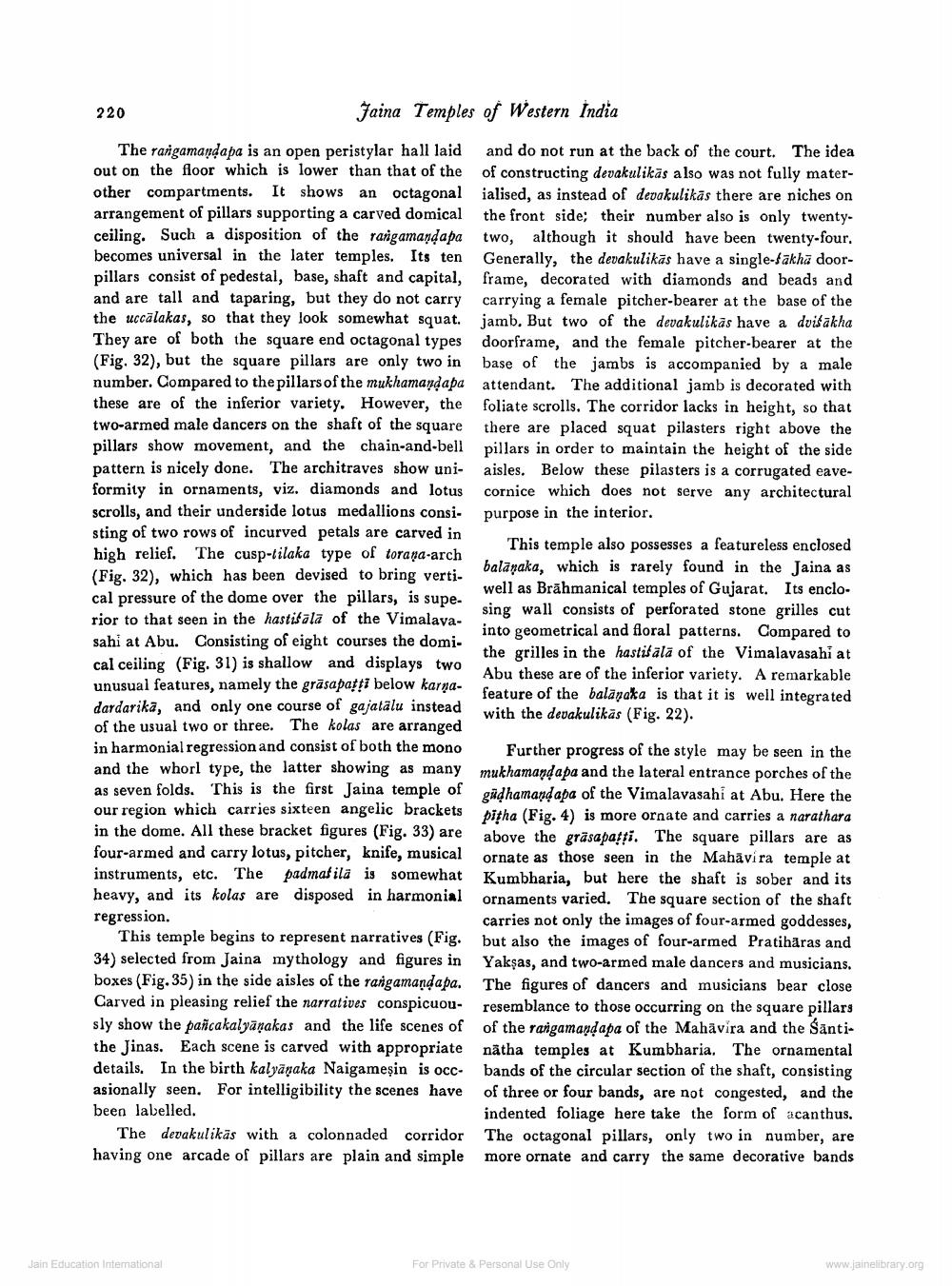________________
220
Faina Temples of Western India
The rangamandapa is an open peristylar hall laid and do not run at the back of the court. The idea out on the floor which is lower than that of the of constructing devakulikäs also was not fully materother compartments. It shows an octagonal ialised, as instead of devakulikās there are niches on arrangement of pillars supporting a carved domical the front side; their number also is only twentyceiling. Such a disposition of the rangamandapa two, although it should have been twenty-four. becomes universal in the later temples. Its ten Generally, the devakulikās have a single-fakhā doorpillars consist of pedestal, base, shaft and capital, frame, decorated with diamonds and beads and and are tall and taparing, but they do not carry carrying a female pitcher-bearer at the base of the the uccälakas, so that they look somewhat squat. jamb. But two of the devakulikās have a dvišakha They are of both the square end octagonal types doorframe, and the female pitcher-bearer at the (Fig. 32), but the square pillars are only two in base of the jambs is accompanied by a male number. Compared to the pillars of the mukhamandapa attendant. The additional jamb is decorated with these are of the inferior variety. However, the foliate scrolls. The corridor lacks in height, so that two-armed male dancers on the shaft of the square there are placed squat pilasters right above the pillars show movement, and the chain-and-bell pillars in order to maintain the height of the side pattern is nicely done. The architraves show uni- aisles. Below these pilasters is a corrugated eaveformity in ornaments, viz. diamonds and lotus cornice which does not serve any architectural scrolls, and their underside lotus medallions consi- purpose in the interior. sting of two rows of incurved petals are carved in
This temple also possesses a featureless enclosed high relief. The cusp-tilaka type of toraņa-arch
balāņaka, which is rarely found in the Jaina as (Fig. 32), which has been devised to bring verti
well as Brāhmanical temples of Gujarat. Its enclocal pressure of the dome over the pillars, is supe.
sing wall consists of perforated stone grilles cut rior to that seen in the hastifāla of the Vimalaya
into geometrical and floral patterns. Compared to sahi at Abu. Consisting of eight courses the domi
the grilles in the hastišala of the Vimalavasahi at cal ceiling (Fig. 31) is shallow and displays two
Abu these are of the inferior variety. A remarkable unusual features, namely the grāsapatti below karna
feature of the balayaka is that it is well integrated dardarika, and only one course of gajatalu instead
with the devakulikäs (Fig. 22). of the usual two or three. The kolas are arranged in harmonial regression and consist of both the mono Further progress of the style may be seen in the and the whorl type, the latter showing as many mukhamand apa and the lateral entrance porches of the as seven folds. This is the first Jaina temple of güdhamandapa of the Vimalavasahi at Abu. Here the our region which carries sixteen angelic brackets bitha (Fig. 4) is more ornate and carries a narathara in the dome. All these bracket figures (Fig. 33) are above the gräsapatti. The square pillars are as four-armed and carry lotus, pitcher, knife, musical
ornate as those seen in the Mahavira temple at instruments, etc. The padmašila is somewhat Kumbharia, but here the shaft is sober and its heavy, and its kolas are disposed in harmonial ornaments varied. The square section of the shaft regression.
carries not only the images of four-armed goddesses, This temple begins to represent narratives (Fig. but also the images of four-armed Pratihäras and 34) selected from Jaina mythology and figures in Yakşas, and two-armed male dancers and musicians. boxes (Fig.35) in the side aisles of the rangamandapa. The figures of dancers and musicians bear close Carved in pleasing relief the narratives conspicuou- resemblance to those occurring on the square pillars sly show the pancakalyanakas and the life scenes of of the rangamandapa of the Mahavira and the Säntithe Jinas. Each scene is carved with appropriate nãtha temples at Kumbharia. The ornamental details. In the birth kalyanaka Naigameşin is occ- bands of the circular section of the shaft, consisting asionally seen. For intelligibility the scenes have of three or four bands, are not congested, and the been labelled.
indented foliage here take the form of acanthus. The devakulikäs with a colonnaded corridor The octagonal pillars, only two in number, are having one arcade of pillars are plain and simple more ornate and carry the same decorative bands
Jain Education International
For Private & Personal Use Only
www.jainelibrary.org




